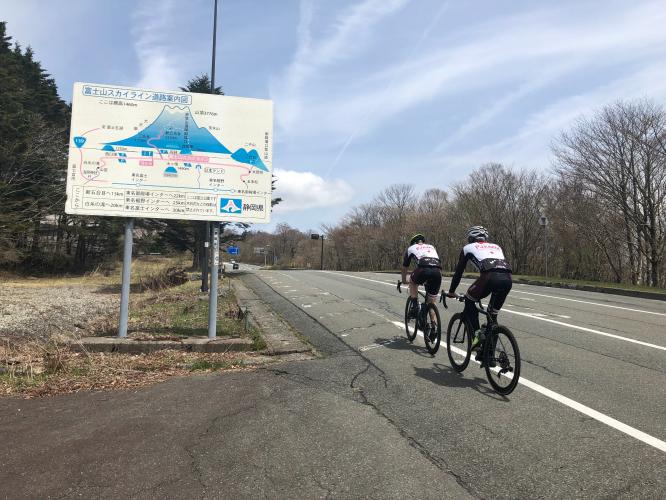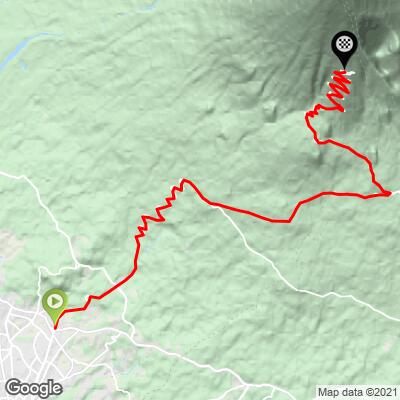![Mt. Fuji - Fujinomiya Line Cycling Mt. Fuji - Fujinomiya Line - panorama drone photo of mt. fuji]()
You will not find a more distinctive mountain anywhere in the world than Mt. Fuji.
Photo by PJAMM Cycling, taken by drone from the northern side of Mt. Fuji.
![Mt. Fuji - Fujinomiya Line Cycling Mt. Fuji - Fujinomiya Line - drone aerial sphere panorama of Mt. Fuji]()
We have taken well over 100,000 photos of mountains and bike climbs throughout the world.
This photo is one of our Top 10 all-time PJAMM Cycling photographs.
![]()
Mt. Fuji as seen from the International Space Station.
Cycling Mt. Fuji’s Fujinomiya Line to the Fujinomiya 5th Station is the longest and most difficult road bike climb in Japan. This extremely challenging bike climb is ranked #1 in Japan and #40 in the world for good reason -- we ride 30 kilometers (18.7 miles) to 2,381 meters (7,811’) gaining 2,044 meters (6,707’) at nearly 7% average grade. Fujinomiya 5th Station is the highest of the four Mt. Fuji 5th Stations (a 5th Station is where the hike to the summit of Mt. Fuji beings). The summit of Mt. Fuji is 3,776 m (12,388’). An excellent summary of what is necessary to hike to the Mt. Fuji summit is found at Japan-guide.com.
CYCLING MT. FUJI TO FUJINOMIYA 5TH STATION
![]()
14 hairpins near the top of the climb.
This magnificent bike climb begins in Fujinomiya by riding north on Highway 180 from just north of its intersection with Highway 469.
![Mt. Fuji - Fujinomiya Line Bicycle climb Mt. Fuji - Fujinomiya Line - 2 cyclist on the road on bikes - photo ground level in forest]()
Highway 180 at kilometer 4.2, 490 meters.
![Mt. Fuji - Fujinomiya Line Climbing Mt. Fuji - Fujinomiya Line by bike - 2 cyclist on bikes on road riding past cherry blossoms]()
During the cherry blossom season, the scenery will be even more spectacular.
![Mt. Fuji - Fujinomiya Line Cycling Mt. Fuji - Fujinomiya Line - 2 cyclists riding past road sign]()
Kilometer 25 -- just at the end of a 2.3 km 10.4% segment.
![Mt. Fuji - Fujinomiya Line Bike climb Mt. Fuji - Fujinomiya Line - cyclists on road near top - parking lot]()
View of riders near the top. Photo taken from the finish of the climb.
![Mt. Fuji - Fujinomiya Line Colombian snowman - Mt. Fuji - Fujinomiya Line]()
Javier, our Colombian photographer had never been in the snow before.
He did a pretty mean snow creature for his first time.
![Mt. Fuji - Fujinomiya Line Cycling Mt. Fuji - Fujinomiya Line - PJAMM cyclists with bikes at the top of the climb]()
That’s a chilly wrap!
PJAMM’s Caleb Kimbrell, Tokyo/San Diego and Mitch Reid, Reno.
WHAT A TRIP
The ascents to the four 5th Stations was first, but definitely not the only, stop on our Top 100 World Cycling Asian adventure.
![Mt. Fuji - Fujinomiya Line cycling Mt. Fuji - Fujinomiya Line - PJAMM Cyclings Asia trip itinerary map]()
PJAMM’s May 2019 Asian Trip Itinerary.
Our guide for the trip, Tim Smith of Astuto Cycling Center (tims@gsastuto.com) was exceptional and we cannot say enough great things about him. To our good fortune Tim was available and willing to guide us for our two days on Mt. Fuji. Tim is a custom builder of high-end cycling wheels who also oversees cycling tours throughout Japan.
Tim picked us up from our hotel at 5 a.m. on Saturday to begin our four Fuji climbs in two days. The next two days were a pure joy – not only does Tim know every inch of Mt. Fuji from each of the four approaches to the 5th Stations, having cycled extensively in Europe and Asia, he is an expert at cycling in general, cycling in Japan, nutrition, and coaching and training (he is a UCI cycling coach).
![Mt. Fuji - Fujinomiya Line Cycling Mt. Fuji - Fujinomiya Line - Tim Smith - Astuto Tours]()
Tim in Full Support Mode!
Tim is originally from the US and speaks English and conversational Japanese, having lived and worked in Japan for 10 years. As with all PJAMM endorsements, they are purely to assist our readers in experiencing climbs throughout the world, and are made only in relation to products and services that we sincerely believe in and appreciate – we receive absolutely no financial benefit from our endorsements. With that qualification, we unequivocally and wholeheartedly recommend using Tim Smith and Astuto for any cycling trip you are interested in that is anywhere near Tokyo, Mt. Fuji and/or the Japanese Alps. Tim’s business has “ongoing cycling excursions and rentals available almost year round” for anyone wishing to climb or ride Fuji. Find out more on Astuto’s website here.
FUJINOMIYA KING OF HILL
This competitive bike race rides along the longest approach to the Fuji 5th Station. We don’t know for sure whether the race will be held again in 2019, the website seems to indicate that it may be cancelled. For more information on the Fujinomiya KOH, look here.
HIKING FROM 5TH STATION TO MT. FUJI SUMMIT
Big-time adventurer Kyle Stanton-Wyman of Bremerton, WA writes for the hike up to Mt. Fuji (as part of our bike-hike sometime in the future):
In regards to a Fuji summer summit - yes I have done that once and it is much more achievable. I climbed the Gotemba route in August of '18 during the official climbing season. Strava link for details and photos.
Fuji (when snow free) is a 'simple' hike and doesn't require any technical climbing skills or equipment, but it is still a very strenuous hike. Gotemba is the longest of the four routes at 7,400 vft, and the other three are around 4,000 vft. Beware that you might suffer from the high altitude, given the summit is at 12,388 ft. It is most popular to start the hike pre-dawn, and summit in time for sunrise as that is typically when the weather is clearest. Given the peak's isolated nature, it is often obscured in clouds by the afternoon. Also be warned that the three shorter trails are EXTREMELY busy during the official climbing season, especially on weekends (check out the picture of the traffic jam of hikers on my strava link). During the official climbing season there are also open noodle huts selling food and water on the summit. Outside the official climbing season, the summit may still be relatively snow free and easy to hike, especially in early fall, and there will be far fewer people, but no services.
Lastly, here are the three rules for off season climbing.
Although the website says it's "prohibited", that's a mis-translation. They just want to make sure you are fully prepared for the conditions.
I'm sure you got the road riding beta from Caleb. Based upon that, I think a bike and hike is perfectly possible on any of the 4 routes!
As the most popular tourist site in Japan, more than 200,000 people climb to the summit of Mt. Fuji each year. There are “huts” along the route to cater to climbers (National Geographic). Our awesome guide Tim explains that there are “now many guide services, bus excursions and suppliers for hiking Fuji...the classic method is to leave late at night, then spend a few hours in one of the mountain shacks, then trek to the summit for sunrise. Fuji is stunning anytime of the day or night -- so you could just climb it anytime. But make sure you can descend in the daylight.” As “the land of the rising sun,” it makes sense that many hikers prefer to see the sunrise from Fuji’s summit. The sunrise upon Mt. Fuji even has a special name, Goraiko (National Geographic). Tim also reminds us to stay safe and come prepared when hiking on Fuji, as “weather on the mountain changes rapidly...you can be in snow, hail, rain, or completely clear skies all within a day. So always pack a light rain jacket and/or gloves for chilly descents, and for sure remember some sunblock.”
This website is excellent and tells you all you need to know about hiking to the top of Mt. Fuji.
If you want to hike to the summit of Fuji, hiking from Fujinomiya 5th Station is a great option. This is the second most popular, and second most developed, of the four 5th stations on the mountain. According to japan-guide.com, the windy road to Fujinomiya’s 5th station, called the Fujisan Syline “used to be a toll road, but it is now free to use. However, the road is closed to private vehicles during the entirety of the official climbing season (July 10 to September 10) when shuttle buses instead operate to a designated parking lot further down the mountain and train stations. The road is also closed during winter from late November to late April.” The Fujinomiya 5th Station is well-stocked with a lot of parking lots, a shop, restaurant, and bathroom facilities. A good tip to note is that this location will be your last chance to get food, water, and other supplies at reasonable prices before the costs rise significantly at higher elevations.
If you don’t quite feel up to hiking to Fuji’s summit from here, japan-guide.com notes that the 5th Station at Fujinomiya also has a shorter hiking trail to a secondary peak and crater on the southeastern slope of Mt. Fuji called Hoeizan. Hoeizan was formed when Mt. Fuji last erupted in 1707 and 1708, during the Hoei Era of the Edo Period.
WHAT’S IN A NAME?
Mt. Fuji’s name meaning is debated, and its etymology is unclear. The current kanji (Japanese writing symbols) for Mount Fuji, “富 and 士, mean "wealth" or "abundant" and "a man of status" respectively,” but this doesn’t tell us much since Fuji’s name predates kanji, “and these characters are ateji, meaning that they were selected because their pronunciations match the syllables of the name but do not carry a meaning related to the mountain” (Mt. Fuji). Potential name meanings include the following: In the 10th century text The Tale of the Bamboo Cutter, Mt. Fuji’s name is said to come from the word “immortal” and the idea of soldiers ascending the mountain’s slopes (ancient samurai used the base of Mt. Fuji as a training area), other tales claim that Fuji’s name means “never ending,” while still others posit it means “without an equal” or “peerless one”. Even British missionary Bob Chiggleson chimed in at some point to suggest that the name comes from the Ainu word for “fire.” So many different definitions exist, but “perhaps Mount Fuji means all of the above. In Japan’s long and winding history, this mountain has always stood there strong, holding different meanings for anyone who ever stood in awe under its shadow” (The Meaning Behind the Name).

 We've partnered with Sherpa-Map.com to bring you the best route planning tool. With a PRO Membership you can use this climb as a reference when creating your route.
We've partnered with Sherpa-Map.com to bring you the best route planning tool. With a PRO Membership you can use this climb as a reference when creating your route. 

